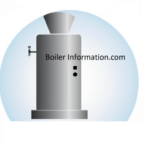A heat exchanger in an industrial boiler is an essential component for transferring thermal energy from one medium to another. It is responsible for exchanging the heat generated by the boiler’s combustion process to the water being heated. This heated water is then used to create steam, which is then used to power the various processes of the industrial plant.
The heat exchanger of an industrial boiler typically consists of a coil or a series of tubes. The tubes are arranged in a bundle in the heat exchanger, and are made from materials that are able to withstand high temperatures and pressure. These tubes are surrounded by a shell, which is attached to the boiler’s combustion chamber. This shell is designed to contain the heat generated by the combustion process and transfer it to the tubes.
The heat exchanger works by allowing hot combustion gases to pass through the tubes. As the hot gases pass through the tubes, they transfer their thermal energy to the walls of the tubes. This thermal energy is then transferred to the water passing through the tubes on the other side. The water absorbs the heat, and is then circulated back to the boiler.
The heat exchanger of an industrial boiler is designed to be highly efficient and reliable. It is designed to minimize heat losses and ensure that the heat generated by the combustion process is maximized. Additionally, the shell is designed to contain the heat and ensure that it is not lost to the surrounding environment.
The heat exchanger of an industrial boiler is a key component for ensuring that the boiler operates safely and efficiently. It is responsible for ensuring that the heat generated by the combustion process is safely transferred to the water, which is then used to generate steam. Without a reliable and efficient heat exchanger, an industrial boiler would not be able to operate properly.
